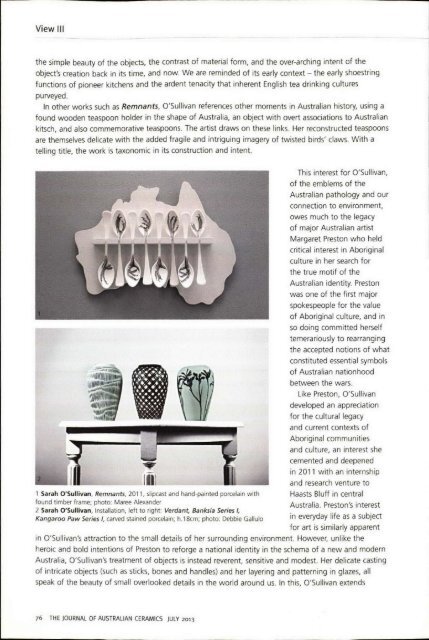The Journal of Australian Ceramics Vol 52 No 2 July 2013
You also want an ePaper? Increase the reach of your titles
YUMPU automatically turns print PDFs into web optimized ePapers that Google loves.
View III<br />
the simple beauty <strong>of</strong> the objects, the contrast <strong>of</strong> material form, and the over-arching intent <strong>of</strong> the<br />
object's creation back in its time, and now. We are reminded <strong>of</strong> its early context - the early shoestring<br />
functions <strong>of</strong> pioneer kitchens and the ardent tenacity that inherent English tea drinking cultures<br />
purveyed.<br />
In other works such as Remnants, O'Sullivan references other moments in <strong>Australian</strong> history, using a<br />
found wooden teaspoon holder in the shape <strong>of</strong> Australia, an object with overt associations to <strong>Australian</strong><br />
kitsch, and also commemorative teaspoons. <strong>The</strong> artist draws on these links. Her reconstructed teaspoons<br />
are themselves delicate with the added fragile and intriguing imagery <strong>of</strong> twisted birds' claws . With a<br />
telling title, the work is taxonomic in its construction and intent.<br />
1 Sarah O'Sullivan, Remnants, 2011 , slipcast and hand-painted porcelain with<br />
found timber frame; photo: Maree Alexander<br />
2 Sarah O'Sullivan, Installation, left to right: Verdant, Banksia Series I,<br />
Kangaroo Paw Series I, carved sta ined porcelain; h.l8cm; photo: Debbie Gallulo<br />
This interest for O'Sullivan,<br />
<strong>of</strong> the emblems <strong>of</strong> the<br />
<strong>Australian</strong> pathology and our<br />
connection to environment,<br />
owes much to the legacy<br />
<strong>of</strong> major <strong>Australian</strong> artist<br />
Margaret Preston who held<br />
critical interest in Aboriginal<br />
culture in her search for<br />
the true motif <strong>of</strong> the<br />
<strong>Australian</strong> identity. Preston<br />
was one <strong>of</strong> the first major<br />
spokespeople for the value<br />
<strong>of</strong> Aboriginal culture, and in<br />
so doing committed herself<br />
temerariously to rearranging<br />
the accepted notions <strong>of</strong> what<br />
constituted essential symbols<br />
<strong>of</strong> <strong>Australian</strong> nationhood<br />
between the wars.<br />
Like Preston, O'Sullivan<br />
developed an appreciation<br />
for the cultural legacy<br />
and current contexts <strong>of</strong><br />
Aboriginal communities<br />
and culture, an interest she<br />
cemented and deepened<br />
in 2011 with an internship<br />
and research venture to<br />
Haasts Bluff in central<br />
Australia. Preston's interest<br />
in everyday life as a subject<br />
for art is similarly apparent<br />
in O'Sullivan's attraction to the small details <strong>of</strong> her surrounding environment. However, unlike the<br />
heroic and bold intentions <strong>of</strong> Preston to reforge a national identity in the schema <strong>of</strong> a new and modern<br />
Australia, O'Sullivan's treatment <strong>of</strong> objects is instead reverent, sensitive and modest. Her delicate casting<br />
<strong>of</strong> intricate objects (such as sticks, bones and handles) and her layering and patterning in glazes, all<br />
speak <strong>of</strong> the beauty <strong>of</strong> small overlooked details in the world around us. In this, O'Sullivan extends<br />
76 THE JOURNAL OF AUSTRALIAN CERAMICS JULY <strong>2013</strong>

















